Yitong Chen
CoMP: Continual Multimodal Pre-training for Vision Foundation Models
Mar 24, 2025Abstract:Pre-trained Vision Foundation Models (VFMs) provide strong visual representations for a wide range of applications. In this paper, we continually pre-train prevailing VFMs in a multimodal manner such that they can effortlessly process visual inputs of varying sizes and produce visual representations that are more aligned with language representations, regardless of their original pre-training process. To this end, we introduce CoMP, a carefully designed multimodal pre-training pipeline. CoMP uses a Continual Rotary Position Embedding to support native resolution continual pre-training, and an Alignment Loss between visual and textual features through language prototypes to align multimodal representations. By three-stage training, our VFMs achieve remarkable improvements not only in multimodal understanding but also in other downstream tasks such as classification and segmentation. Remarkably, CoMP-SigLIP achieves scores of 66.7 on ChartQA and 75.9 on DocVQA with a 0.5B LLM, while maintaining an 87.4% accuracy on ImageNet-1K and a 49.5 mIoU on ADE20K under frozen chunk evaluation.
Comprehensive Multi-Modal Prototypes are Simple and Effective Classifiers for Vast-Vocabulary Object Detection
Dec 23, 2024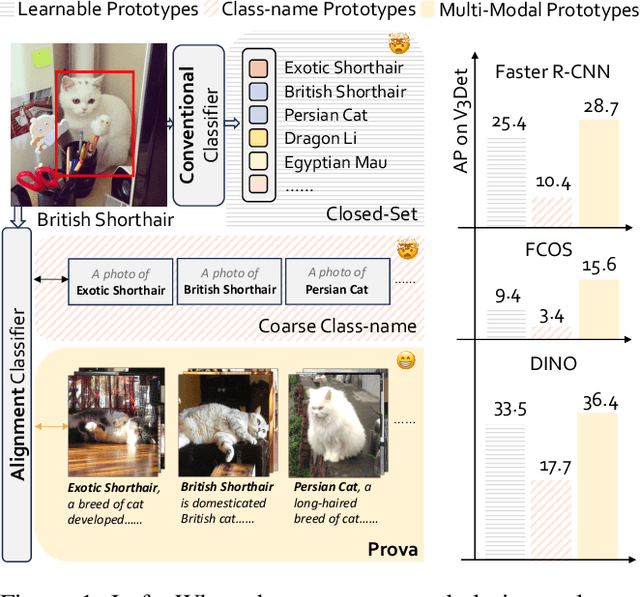
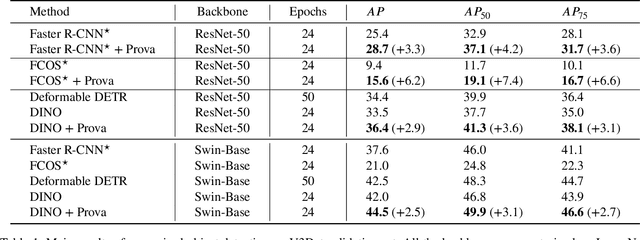


Abstract:Enabling models to recognize vast open-world categories has been a longstanding pursuit in object detection. By leveraging the generalization capabilities of vision-language models, current open-world detectors can recognize a broader range of vocabularies, despite being trained on limited categories. However, when the scale of the category vocabularies during training expands to a real-world level, previous classifiers aligned with coarse class names significantly reduce the recognition performance of these detectors. In this paper, we introduce Prova, a multi-modal prototype classifier for vast-vocabulary object detection. Prova extracts comprehensive multi-modal prototypes as initialization of alignment classifiers to tackle the vast-vocabulary object recognition failure problem. On V3Det, this simple method greatly enhances the performance among one-stage, two-stage, and DETR-based detectors with only additional projection layers in both supervised and open-vocabulary settings. In particular, Prova improves Faster R-CNN, FCOS, and DINO by 3.3, 6.2, and 2.9 AP respectively in the supervised setting of V3Det. For the open-vocabulary setting, Prova achieves a new state-of-the-art performance with 32.8 base AP and 11.0 novel AP, which is of 2.6 and 4.3 gain over the previous methods.
Inst-IT: Boosting Multimodal Instance Understanding via Explicit Visual Prompt Instruction Tuning
Dec 04, 2024



Abstract:Large Multimodal Models (LMMs) have made significant breakthroughs with the advancement of instruction tuning. However, while existing models can understand images and videos at a holistic level, they still struggle with instance-level understanding that requires a more nuanced comprehension and alignment. Instance-level understanding is crucial, as it focuses on the specific elements that we are most interested in. Excitingly, existing works find that the state-of-the-art LMMs exhibit strong instance understanding capabilities when provided with explicit visual cues. Motivated by this, we introduce an automated annotation pipeline assisted by GPT-4o to extract instance-level information from images and videos through explicit visual prompting for instance guidance. Building upon this pipeline, we proposed Inst-IT, a solution to enhance LMMs in Instance understanding via explicit visual prompt Instruction Tuning. Inst-IT consists of a benchmark to diagnose multimodal instance-level understanding, a large-scale instruction-tuning dataset, and a continuous instruction-tuning training paradigm to effectively enhance spatial-temporal instance understanding capabilities of existing LMMs. Experimental results show that, with the boost of Inst-IT, our models not only achieve outstanding performance on Inst-IT Bench but also demonstrate significant improvements across various generic image and video understanding benchmarks. This highlights that our dataset not only boosts instance-level understanding but also strengthens the overall capabilities of generic image and video comprehension.
The D-Subspace Algorithm for Online Learning over Distributed Networks
Oct 26, 2024Abstract:This material introduces the D-Subspace algorithm derived on the basis of the centralized algorithm [1], which originally addresses parameter estimation problems under a subspace constraint.
Dual-TSST: A Dual-Branch Temporal-Spectral-Spatial Transformer Model for EEG Decoding
Sep 05, 2024



Abstract:The decoding of electroencephalography (EEG) signals allows access to user intentions conveniently, which plays an important role in the fields of human-machine interaction. To effectively extract sufficient characteristics of the multichannel EEG, a novel decoding architecture network with a dual-branch temporal-spectral-spatial transformer (Dual-TSST) is proposed in this study. Specifically, by utilizing convolutional neural networks (CNNs) on different branches, the proposed processing network first extracts the temporal-spatial features of the original EEG and the temporal-spectral-spatial features of time-frequency domain data converted by wavelet transformation, respectively. These perceived features are then integrated by a feature fusion block, serving as the input of the transformer to capture the global long-range dependencies entailed in the non-stationary EEG, and being classified via the global average pooling and multi-layer perceptron blocks. To evaluate the efficacy of the proposed approach, the competitive experiments are conducted on three publicly available datasets of BCI IV 2a, BCI IV 2b, and SEED, with the head-to-head comparison of more than ten other state-of-the-art methods. As a result, our proposed Dual-TSST performs superiorly in various tasks, which achieves the promising EEG classification performance of average accuracy of 80.67% in BCI IV 2a, 88.64% in BCI IV 2b, and 96.65% in SEED, respectively. Extensive ablation experiments conducted between the Dual-TSST and comparative baseline model also reveal the enhanced decoding performance with each module of our proposed method. This study provides a new approach to high-performance EEG decoding, and has great potential for future CNN-Transformer based applications.
Large-scale neuromorphic optoelectronic computing with a reconfigurable diffractive processing unit
Aug 26, 2020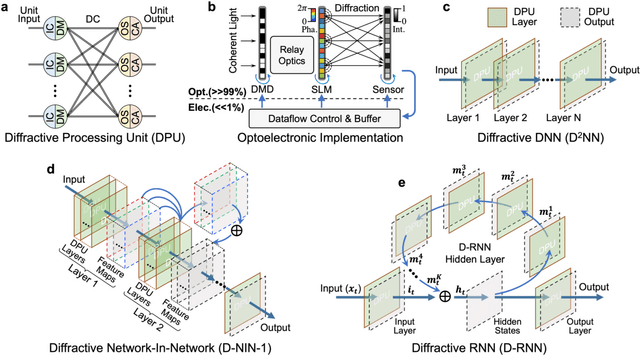
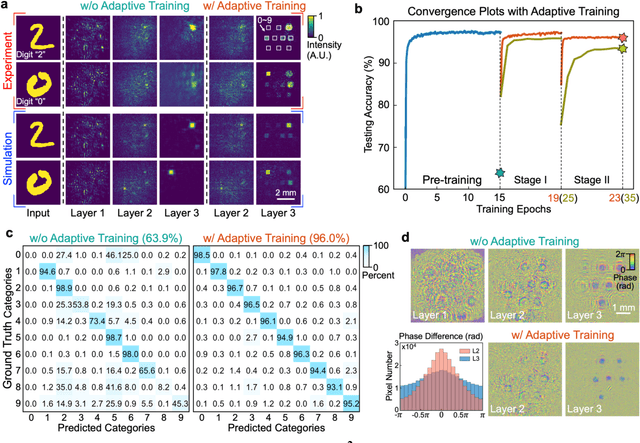
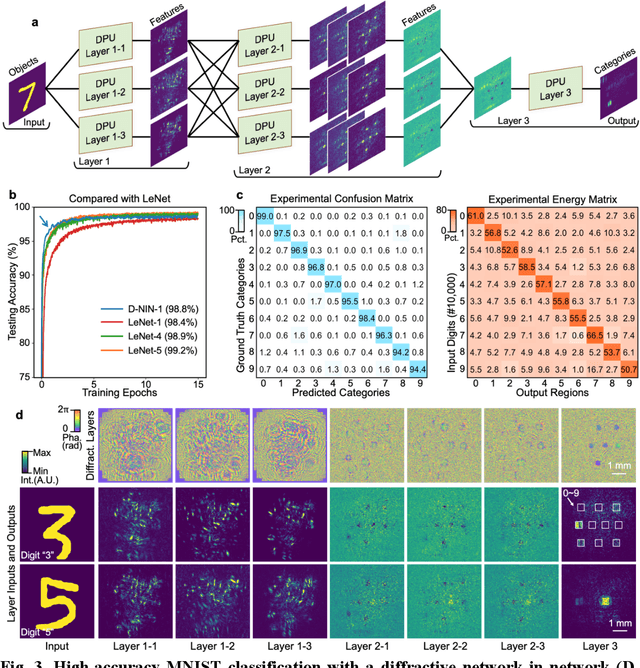
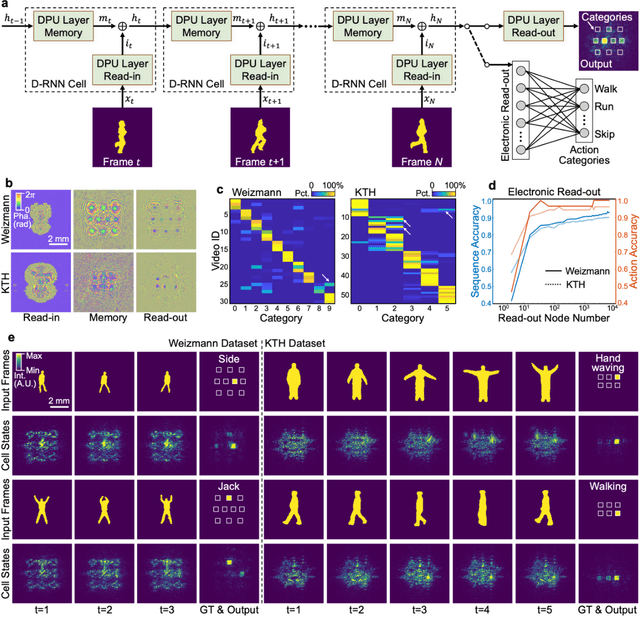
Abstract:Application-specific optical processors have been considered disruptive technologies for modern computing that can fundamentally accelerate the development of artificial intelligence (AI) by offering substantially improved computing performance. Recent advancements in optical neural network architectures for neural information processing have been applied to perform various machine learning tasks. However, the existing architectures have limited complexity and performance; and each of them requires its own dedicated design that cannot be reconfigured to switch between different neural network models for different applications after deployment. Here, we propose an optoelectronic reconfigurable computing paradigm by constructing a diffractive processing unit (DPU) that can efficiently support different neural networks and achieve a high model complexity with millions of neurons. It allocates almost all of its computational operations optically and achieves extremely high speed of data modulation and large-scale network parameter updating by dynamically programming optical modulators and photodetectors. We demonstrated the reconfiguration of the DPU to implement various diffractive feedforward and recurrent neural networks and developed a novel adaptive training approach to circumvent the system imperfections. We applied the trained networks for high-speed classifying of handwritten digit images and human action videos over benchmark datasets, and the experimental results revealed a comparable classification accuracy to the electronic computing approaches. Furthermore, our prototype system built with off-the-shelf optoelectronic components surpasses the performance of state-of-the-art graphics processing units (GPUs) by several times on computing speed and more than an order of magnitude on system energy efficiency.
 Add to Chrome
Add to Chrome Add to Firefox
Add to Firefox Add to Edge
Add to Edge